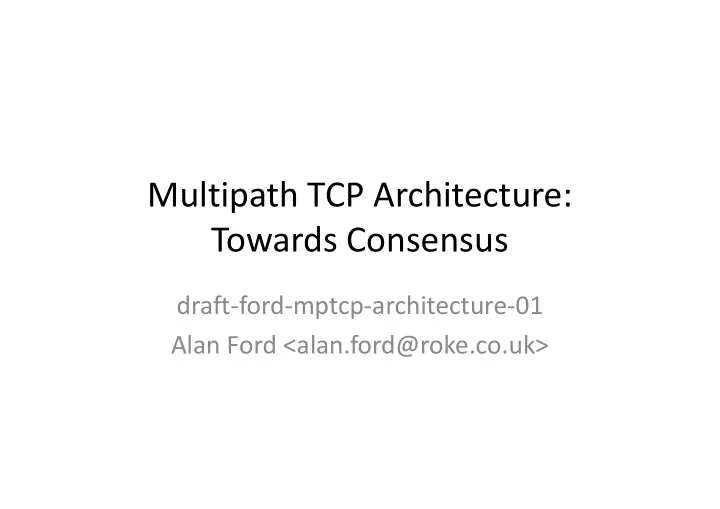

Multipath TCP Architecture: Towards Consensus Towards Consensus draft-ford-mptcp-architecture-01 Alan Ford <alan.ford@roke.co.uk>
Goals of Draft Overview of MPTCP • Motivation and goals for Multipath TCP • Functional architecture • High-level design decisions • High-level design decisions • How components (drafts) fit together 2
Motivation and Functional Goals • Increase resilience of connectivity – => Use of multiple paths interchangeably • Increase throughput – => Use of multiple paths simultaneously – => Use of multiple paths simultaneously – Also increases efficiency of global resource utilisation 3
Compatibility Goals • Application Compatibility – Appearance of MPTCP to the application – Maintain API compatibility (extensions permitted) – Maintain regular TCP service model – Maintain regular TCP service model • Network compatibility – Look like regular TCP – Traverse common middleboxes • Compatibility with other network users – Coexist gracefully with other TCP flows 4
MPTCP Functional Modules • Path Management – Detection and use of multiple paths between endpoints: achieved through multiple IP addresses • Packet Scheduling – Breaking bytestream from application into segments – Breaking bytestream from application into segments for transmission on subflows • Subflow Interface – Sends scheduled packets with necessary metadata to lower TCP layers • Congestion Control – Managed across subflows 5
High-Level Design Decisions 6
Sequence Numbering • Two layers of sequence numbering – Keep each subflow-level independent – Add mapping to data-level sequence numbering – Full mapping of (data_seq, subflow_seq, length) but this could be implied in cases this could be implied in cases • Reasoning – Appear as continuous flow to middleboxes – Allow packet loss and acknowledgement to be attributed to the correct subflow in the case of retransmission 7
Reliability • ACKs at subflow level only • Connection-level ACKs are therefore derived • Pros: – Reduced complexity and overhead – Reduced complexity and overhead • Cons: – If a subfow is ACKed and the data is later lost, the connection stalls permanently • Cases: middlebox failure; memory pressure • Are these things we need to worry about? • Do we need an explicit connection-level ACK? 8
Retransmissions • Dual-level sequence numbering and subflow-level ACKs can determine lost data • Retransmission algorithms are TBD • To maintain integrity of subflows, different data • To maintain integrity of subflows, different data cannot be retransmitted on previously allocated cannot be retransmitted on previously allocated subflow sequence space • So even if data is retransmitted on another subflow, must also still be retransmitted on the previous one – This will affect optimal retransmission algorithms 9
Path and Connection Management • Paths identified by IP address pairs • MPTCP-aware applications can use a MPTCP- specific connection identifier (analogous to ephemeral port for demultiplexing) • Legacy applications must be presented with a 5- • Legacy applications must be presented with a 5- tuple – the 5-tuple of the first subflow. Complications if this subflow closes: – Does connection have to close? – Note that binding to an address will not use MPTCP – Proposal: close connection unless extended API is used (or overridden in OS – out of scope) 10
Middleboxes (1) • Dedicated section is still a TBD in the draft, but impact is felt throughout • Has been a factor in the protocol design so far • But where can we draw the line? • But where can we draw the line? Some examples: • Middleboxes that prevent connections in one direction (firewalls, NATs) – Solved by signalling addresses 11
Middleboxes (2) • Terminating middleboxes (e.g. PEPs) – May do proactive ACKing – May drop TCP Options – (Fall back to behaviour as regular TCP) – (Fall back to behaviour as regular TCP) • Middleboxes that care about TCP – May change sequence numbering – May do packet coalescing or splitting – Do not put holes in sequence space 12
Other Issues in the Draft • Buffer sizes – Optimality TBD • Signalling – See options vs payload discussion • Support for both v4 and v6 • Support for both v4 and v6 – Uncontentious? • Congestion control – See separate draft • Receive windows – Per-connection only – per-subflow could lead to deadlocks 13
Next steps? 14
Recommend
More recommend